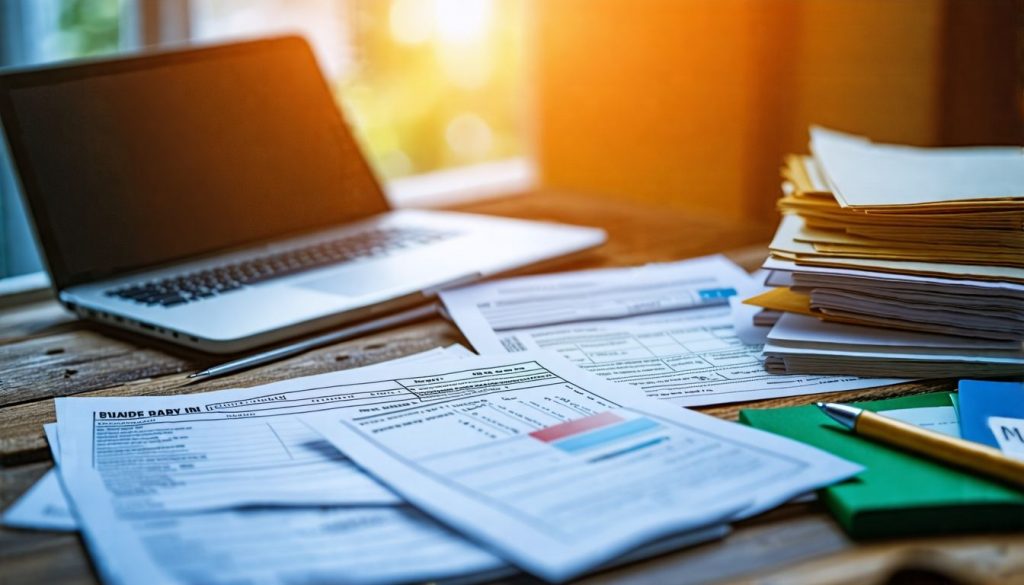Struggling to keep up with credit card payments is a common challenge. One fact to consider: high APRs can significantly increase your debt over time. This article offers strategies for credit card payoff, helping you reduce your burden faster.
Get ready to tackle your debt!
Key Takeaways
- Use the Debt Avalanche Method to pay down debts with high interest rates first, saving you money and speeding up your debt payoff process. This method involves listing all your debts by interest rate, paying minimums on all but focusing extra payments on the highest rates.
- Creating a detailed budget is key for managing and eliminating credit card debt. Track your income and expenses carefully, cut unnecessary spending, and use any extra money towards paying off high-interest cards.
- Explore consolidation loans or balance transfer cards as options to lower APRs on your existing credit card debt. These tools can help simplify payments and potentially reduce the amount of interest paid over time.
- Embrace smart spending habits by setting realistic budgets, avoiding impulse purchases, using low-interest credit cards responsibly, and monitoring monthly statements to prevent fraud.
- Reaching out for professional financial advice or counseling can provide customized strategies to manage debt more effectively if you are struggling to keep up with multiple credit card payments.
Understanding Credit Card Debt and Its Impact
Credit card debt can weigh heavily on your finances. High interest rates and minimum payments can make it hard to pay off the balance, leading to a cycle of debt that is difficult to break.
APR (Annual Percentage Rate)
The Annual Percentage Rate (APR) represents the yearly interest charged on borrowed money. This figure is crucial for understanding credit card debt payoff. A higher APR means more money spent in interest, increasing the overall cost of your credit card balance.
Canadians should pay close attention to their cards’ APRs when considering which debts to prioritize.
Making only minimum payments prolongs repayment and accumulates more interest over time. Monthly payments that are small may seem manageable initially but can lead to significant debt accumulation if high-interest rates apply.
Utilizing a debt repayment calculator will help track your progress as you work towards eliminating credit card debt effectively.
A clear understanding of APR can save you hundreds, even thousands, in interest.
Minimum Payments
Minimum payments on credit cards are designed to keep accounts in good standing. Typically, this amount is a small percentage of your total balance, often around 2-4%. While it may seem like an easy way to manage debt, only making minimum payments can prolong the payoff period significantly.
High interest rates associated with credit cards mean that you could end up paying much more than the original amount owed over time.
Failing to pay more than the minimum can lead to mounting debt and financial stress. Understanding how much goes toward interest versus principal is crucial for effective financial planning for debt elimination.
Knowing these figures will help you appreciate why higher repayments accelerate your journey towards financial freedom and eliminate debt quickly. Exploring different payoff strategies next will provide insights into smart money management techniques that work best for your situation.
High Interest Rates
High interest rates significantly impact your ability to manage credit card debt effectively. In Canada, many credit cards charge APRs that can soar above 20%. This means that carrying a balance will accrue high interest costs each month.
Paying only the minimum payment allows much of this interest to accumulate, making it harder to pay off the principal amount owed. Utilizing an interest calculator can help you understand how quickly debts can grow when subjected to such rates.
Managing high-interest credit card balances requires strategic planning and disciplined repayment methods. Employing effective debt elimination strategies like the Debt Avalanche Method can reduce overall payments by targeting high-interest accounts first.
Strategies for Credit Card Payoff
Paying off credit card debt requires careful planning and commitment. Implementing effective strategies can help you reduce your balances quickly and regain control of your finances.
Debt Avalanche Method
The Debt Avalanche Method helps Canadians pay off credit card debt quickly by prioritizing accounts with the highest interest rates. This strategy reduces the overall interest paid, leading to faster debt elimination.
- Identify Your Debts
List all your credit cards along with their balances and annual percentage rates (APRs). This gives a clear picture of your financial situation and helps you focus on what matters most.
- Prioritize High Interest Rates
Arrange your debts from the highest APR to the lowest. Concentrating on high-interest debts minimizes costs, allowing you to save money in the long run.
- Make Minimum Payments
Continue making minimum payments on all your other credit cards while focusing on the one with the highest interest rate. This keeps you out of trouble while allocating more funds toward eliminating high-cost debt.
- Allocate Extra Funds
Direct any extra money, such as bonuses or tax returns, toward the card with the highest APR. This approach accelerates your payoff timeline significantly.
- Track Progress Regularly
Check your progress monthly to stay motivated and adjust if necessary. Seeing how much balance decreases can boost morale and encourage continuing efforts.
- Celebrate Milestones
Small wins matter too! Celebrate each time you pay off a card completely or reach a significant payment milestone. Staying positive makes managing multiple credit cards easier.
- Shift Focus After Paying Off Each Card
Once you’ve eliminated one card, shift attention to the next one with the highest interest rate, continuing this cycle until you’re debt-free. The momentum built can help maintain motivation throughout your journey.
- Avoid New Debt Accumulation
Resist adding new expenses to existing credit cards during this process. Sticking strictly to a repayment plan enhances its effectiveness and leads toward financial freedom more rapidly.
Debt Snowball Method
The Debt Snowball Method helps you pay off credit card balances effectively. This strategy focuses on paying off the smallest debts first, creating momentum and motivation as you eliminate each balance.
- List Your Debts
Write down all your credit card debts in order from the smallest balance to the largest. This list should include the total amounts owed and the minimum payment for each account.
- Make Minimum Payments
Pay only the minimum payments on all your credit cards except for the smallest debt. This ensures that other accounts remain current while you focus your extra funds on one specific balance.
- Focus on the Smallest Debt
Put any extra money toward the smallest debt after covering minimum payments on others. Use any funds saved from cutting expenses or adjusting your budget to increase this payoff amount.
- Celebrate Small Wins
Once you pay off a smaller debt, celebrate this achievement! Positive reinforcement can motivate you to continue tackling larger debts using this technique.
- Move to the Next Debt
After eliminating a small balance, take that same amount of money and direct it towards your next smallest debt along with its minimum payment. This creates a growing “snowball” effect as more cash becomes available for subsequent repayments.
- Keep Building Momentum
Continue this process until all debts are paid off. Each time a balance is eliminated, apply that previous payment amount to upcoming debts, propelling you forward in your journey toward financial freedom.
- Stay Committed to Your Plan
Maintain discipline in following this repayment strategy and avoid accruing new credit card debt during this period. Focus on budgeting effectively and controlling spending habits through strategic savings techniques.
This approach makes use of effective debt reduction techniques by simplifying how to manage multiple credit cards without feeling overwhelmed.
Consolidation Loans or Balance Transfer Cards
Consolidation loans and balance transfer cards offer effective ways to manage credit card debt. A consolidation loan allows you to combine multiple debts into a single monthly payment, usually at a lower Annual Percentage Rate (APR) than your existing accounts.
This can make payments more manageable and save money on interest over time.
Balance transfer cards enable you to move high-interest balances from several credit cards onto one new card, often with an introductory period of low or zero interest rates. Canadians can benefit by prioritizing paying off these transferred balances before the promotional rate expires, reducing the overall cost of debt management significantly.
Both options serve as vital tools in your credit card repayment plans, aiding in achieving financial freedom and eliminating debt faster.
Utilizing Budgeting and Saving Techniques
Creating a budget and saving money can significantly help in paying off credit card debt faster. Effective financial planning allows you to focus on making consistent monthly payments while reducing unnecessary expenses.
- Set a Detailed Budget: Track your income and expenses closely. This helps you see where your money goes each month. Create categories for essentials like housing, food, and utilities, as well as discretionary spending. Each dollar saved can go toward your credit card balances.
- Cut Unnecessary Expenses: Identify areas where you can cut back on spending. This might include dining out less often or canceling unused subscriptions. Every dollar you redirect from these savings can make a difference in your debt payoff strategy.
- Prioritize Debt Payments: Allocate extra cash towards higher-interest credit cards first. This approach not only reduces overall interest payments but also aligns with the debt avalanche method of credit card payoff. Paying more than the minimum payment enables quicker reductions in principal balances.
- Automate Savings: Set up automatic transfers to a savings account each payday. It prevents the temptation to spend that money and creates a safety net for unexpected expenses, decreasing reliance on credit cards for emergencies.
- Utilize Cash-Back Programs Wisely: If using credit cards is unavoidable, select those offering cash-back rewards for purchases you intend to make anyway. Use this extra income towards your debt; it acts as an effective tool within your budgeting framework.
- Plan for Irregular Expenses: Include room in your budget for irregular costs like car repairs or seasonal expenses such as holidays or vacations. Set aside small amounts each month to avoid relying on credit when these costs arise unexpectedly.
- Use Financial Apps: Leverage technology by utilizing budgeting apps that can help track spending and savings goals effortlessly. These tools provide insights into your habits, allowing adjustments that streamline your finances better toward maintaining low credit card balances.
- Create an Emergency Fund: Aim to save at least three months’ worth of living expenses before aggressively paying down debt. An emergency fund cushions against unforeseen costs without resorting back to credit cards, supporting long-term financial health.
- Review Your Progress Regularly: Keep track of how well you stick to your budget and monitor changes in your debts every month or quarter. Regular evaluations allow you to adjust strategies and ensure all efforts contribute effectively towards eliminating credit card debts swiftly.
- Seek Professional Advice if Needed: Consulting with a financial advisor may provide personalized techniques best suited for managing multiple lines of credit effectively during challenging times when circumstances don’t allow for straightforward repayment plans.
Incorporating these budgeting and saving techniques into daily life will empower Canadians on their journey toward financial freedom by ensuring efficient management of their credit card debts while improving overall financial literacy.
Seeking Professional Help
Utilizing budgeting and saving techniques can provide a strong foundation for managing credit card debt. Seeking professional help may also be beneficial if you find it challenging to stay on track.
Financial advisors, credit counseling services, or debt management programs offer guidance tailored to your situation. They can assist with debt management techniques, creating repayment plans, and exploring options like credit card consolidation.
Professional support helps streamline your efforts in paying off credit card balances more efficiently while building a pathway towards financial freedom.
Tips for Managing Multiple Credit Cards
Managing multiple credit cards can be tricky. Set a clear repayment plan for each card to avoid missed payments and rising debt.
Pros and cons of having multiple credit cards
Handling finances wisely is crucial for Canadians aiming to balance their credit usage effectively. Having multiple credit cards presents both advantages and disadvantages. Below is a breakdown designed to guide Canadians through the decision-making process regarding the management of multiple credit cards.
| Pros | Cons |
|---|---|
| Improves credit score by diversifying credit accounts | Increases the risk of accumulating debt if not managed wisely |
| Offers a variety of rewards and benefits like travel points, cash back, and insurance | Can lead to a complicated financial situation with multiple billing cycles and due dates |
| Enables users to maximize rewards and bonuses by using specific cards for particular purchases | Potential for higher annual fees from multiple cards, adding to expenses |
| Provides a backup in case of loss, fraud, or emergency situations | May negatively impact credit scores if total credit utilization is high |
| Allows for keeping business and personal expenses separate, simplifying record-keeping | Requires disciplined financial management to avoid overspending |
Effectively managing multiple credit cards involves a strategic approach to spending, paying bills on time, and regularly monitoring credit scores to ensure financial health. This strategy empowers Canadians to harness the benefits while mitigating the risks associated with having multiple credit cards.
Drawbacks of multiple credit cards
Having multiple credit cards can lead to serious pitfalls. Juggling various accounts may confuse your payment schedules and result in missed payments. Such oversights can harm your credit score, which affects future borrowing options.
Additionally, the temptation to overspend increases when multiple cards are available. This behavior often leads to higher overall debt levels and makes it harder to follow effective credit card debt management strategies.
Late fees and interest charges can accumulate quickly if you fail to keep track of due dates for each card. The annual percentage rate (APR) on unpaid balances further compounds this issue, making repayment more challenging over time.
A sensible approach includes creating a repayment plan for each card while focusing on eliminating high-interest debts first.
How to use credit cards responsibly
Using credit cards responsibly helps Canadians maintain their financial health while enjoying the benefits of credit. Smart management can prevent debt and promote a balanced budget.
- Set a Budget: Create a monthly budget that includes all your expenses and income. Allocate a specific amount for credit card payments. This ensures you know exactly how much you can afford to spend.
- Pay More Than the Minimum: Always try to pay more than the minimum payment required each month. Paying only the minimum prolongs debt repayment and increases interest costs due to high annual percentage rates (APR).
- Keep Track of Spending: Monitor your purchases regularly. Use a mobile app or spreadsheet to log expenses, making it easier to stick to your budget and avoid overspending.
- Choose Low-Interest Cards: Opt for credit cards with lower interest rates when applying for new ones or considering balance transfer cards. Lower interest rates reduce total payments over time, aiding in debt payoff strategies.
- Avoid Unnecessary Charges: Only use your credit card for essential purchases or planned expenses, not impulse buys. This practice reinforces responsible spending habits.
- Establish Payment Reminders: Set up payment reminders on your phone or calendar to ensure timely payments and avoid late fees, which can add to existing debt.
- Limit Credit Card Usage: If managing multiple credit cards becomes overwhelming, consider limiting usage to one or two cards for everyday transactions. Fewer cards simplify tracking and budgeting.
- Build an Emergency Fund: Save money regularly in an emergency fund separate from your credit card use. Having this safety net reduces reliance on credit during unexpected situations.
- Review Statements Monthly: Review monthly statements carefully for any unauthorized charges or errors promptly report them if needed. This habit protects against fraud and keeps spending in check.
- Educate Yourself About Credit Management: Stay informed about managing credit effectively by reading articles or attending workshops on budgeting for debt freedom and responsible use of finance tools.
With these practices in place, Canadians can navigate the challenges of using multiple credit cards while keeping their finances secure and improving their chances of achieving financial freedom through effective repayment plans.
Creating a repayment plan for each card
A repayment plan helps you stay organized and focused on eliminating debt from each card. It allows for clear tracking of your progress while keeping interest rates in mind.
- List all credit cards: Write down each credit card, including its balance, APR (Annual Percentage Rate), and minimum payment. This gives a comprehensive view of your debts.
- Prioritize payments: Choose either the Debt Avalanche Method or the Debt Snowball Method to determine which card to pay off first. The Avalanche Method tackles high-interest cards first, while the Snowball Method focuses on smaller balances for quick wins.
- Calculate monthly payments: Use a minimum payment calculator to figure out how much you need to pay each month towards each card. Aim to pay more than the minimum if possible to reduce interest paid over time.
- Set specific goals: Create realistic repayment goals for each card based on your budget and income. This keeps you motivated as you reach benchmarks along the way.
- Adjust your budget: After setting up goals, reassess monthly expenses and adjust your budgeting strategies to find additional funds for repayments. Cutting unnecessary spending can significantly boost payment amounts.
- Monitor progress regularly: Check your repayment plan every month and update it as needed. Life changes may impact income or expenses, so staying flexible is crucial in managing multiple credit cards.
- Consider consolidation options: Look into credit card consolidation options if juggling multiple payments becomes overwhelming. These options can simplify payments into one lower monthly amount with potentially better terms.
- Seek support if needed: Don’t hesitate to ask for help from financial professionals if managing payments feels too challenging alone. They can offer advice tailored to your financial situation.
Creating a repayment plan empowers Canadians to tackle credit card debt effectively while working toward financial freedom and stability.
How to Achieve Financial Freedom and Eliminate Debt
To achieve financial freedom, set clear and realistic goals for your spending. Cut unnecessary expenses and find ways to increase your income to help reduce debt effectively.
Setting realistic goals
Setting realistic goals is crucial for effective credit card payoff. Canadians should establish specific targets that consider their income, expenses, and the total debt amount. Break down larger debts into manageable monthly payment plans to maintain motivation and monitor progress easily.
For instance, if you owe $5,000 across multiple cards with high-interest rates, aiming to pay off a fixed percentage each month can lead to significant reductions in both your balance and interest charges.
Focus on short-term milestones alongside long-term objectives. Celebrate small victories like paying off one card or reducing your total debt by a certain percentage. This approach fosters a sense of accomplishment while reinforcing commitment to eliminating debt fast using strategies for credit card payoff.
Cutting expenses and increasing income
Cutting expenses is essential for quick credit card payoff. Start by reviewing monthly bills and identifying areas to save. Cancel unused subscriptions and negotiate better rates on services like internet or phone plans.
Small changes, such as cooking at home instead of dining out, can lead to significant savings over time.
Increasing income can also accelerate debt elimination. Consider picking up a part-time job or freelancing in your spare time. Selling items you no longer need or using skills for side gigs can provide extra cash flow.
Both strategies contribute to faster repayment of high-interest debts while helping you regain control over finances. The next section will explore maintaining a budget and sticking to it effectively.
Maintaining a budget and sticking to it
Creating and maintaining a budget is essential for effective credit card payoff. It provides clarity on income and expenses, helping to identify areas where savings can be made. A budget enables Canadians to allocate specific amounts toward debt repayment each month.
Sticking to this plan requires discipline and commitment.
Regularly reviewing the budget allows for adjustments based on changing financial situations. This practice helps keep spending in check while ensuring that extra funds go towards paying off high-interest debts quickly.
Making budgeting a routine habit significantly increases the chances of eliminating credit card debt fast, improving overall financial health in the long run.
Building an emergency fund
Building an emergency fund is crucial for financial stability. This fund acts as a safety net, covering unexpected expenses like car repairs or medical bills without resorting to credit cards.
Aim to save at least three to six months’ worth of living expenses. Start with small, manageable contributions and gradually increase them as your budget allows.
This strategy not only helps prevent future credit card debt but also promotes peace of mind about your finances. Effective management of an emergency fund sets the foundation for achieving long-term financial freedom and eliminating debt fast through thoughtful planning and discipline.
Avoiding future credit card debt
Establishing an emergency fund helps prevent future credit card debt. This financial cushion allows you to cover unexpected expenses without relying on your credit cards. Aim for three to six months’ worth of living expenses in this fund.
Practicing responsible budgeting is crucial. Allocate a portion of your income towards savings and avoid impulse purchases. Setting spending limits can help maintain control over finances, reducing reliance on credit cards altogether.
Consistent monitoring of your budget fosters better money management and keeps you from falling back into debt.
Conclusion
Eliminating credit card debt requires a strategic approach. Focus on methods like the debt avalanche or snowball to tackle payments effectively. Implement budgeting techniques and consider consolidation options for relief.
Set clear goals and create an emergency fund to prevent future debt. Stay committed to your financial journey, and enjoy the freedom that comes with being debt-free.
FAQs
1. What are some strategies for credit card payoff to eliminate debt fast?
Strategies for credit card payoff include making more than the minimum payment, focusing on high-interest cards first, and considering balance transfers.
2. How does the Annual Percentage Rate (APR) affect my credit card debt?
The APR is a measure of how much interest you’ll pay on your credit card debt over a year. A higher APR means you’ll owe more in interest, which can slow down your efforts to eliminate debt fast.
3. Can I reduce my APR to speed up my credit card payoff?
Yes, one strategy could be negotiating with your credit card company for a lower annual percentage rate (APR). This can help you save money on interest and pay off your debt faster.
4. Is it possible to eliminate my credit card debt quickly without using any specific strategies?
Without employing strategies like paying more than the minimum or reducing your APR, it may take longer to eliminate your credit card debt due to accruing interest.









